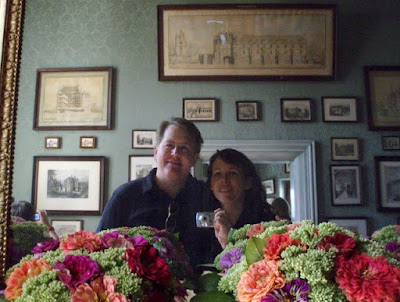The house is centered around an octagonal tower. It was built in 1471 and was a royal residence until King François I invited his friend da Vinci to stay here in 1516.
Leonardo spent the last years of his life working on his drawings and paintings, and meeting almost daily with the King, who appointed him as the royal "first painter, architect, and engineer". The basement of the house is full of working models that were created by IBM using da Vinci's original drawings.
 |
| Shown here is a view of the basement, a gear-driven vehicle/precursor to the car, a suspension bridge, and a military tank. |
 |
| More models include this swing bridge and this paddle boat mechanism. |
There were screens with animated models: this one demonstrates the Archimedes screw for conveying water up an incline. Although he didn't invent the Archimedes screw, da Vinci used the theory behind it for some of his other inventions.
Clos Lucé is less than a quarter mile from François I's royal residence at the Château d'Amboise. The two houses were connected by an underground passage allowing the king to visit his friend more easily.
Much of the rest of the home's interior has been restored with furnishings from Leonardo's time. Here is a view of the kitchen, where the cook Mathurine would prepare his vegetarian meals.
Upstairs is Leonardo's bedroom. The furnishings are from the Renaissance era, but are not original to the house during the time Leonardo lived here.
Here are a few more views of the furnishings.
 |
| Bedroom of Marguerite de Navarre |
 |
| View of the garden through the bedroom window |
 |
| An arch from the painted chapel ceiling |
What I liked was that they had built full-size working replicas of the models from Leonardo's drawings. Here is Kevin at the swivel bridge.
Overall, Clos Lucé was worth a visit. We wouldn't consider it a château in the "castle" sense of the word, but it was beautifully restored and the facts about Leonardo's time there were really well-presented.
 |
| View of Clos Luce from the garden |
Next it was on to a true castle: Chenonceau. This impressive palace was built in stages. In 1515 Thomas Bohier and his wife Katherine Briçonnet demolished a previously existing castle and mill to build a large castle next to the river. Looking at the photo below, you can see the Bohier part on the right -- at that time there was no bridge across the river Cher. Later the château became the property of the crown, and the French king Henry II gave the palace to his mistress Diane de Poitiers in 1547. She had gardens installed on both sides of the river, and extended the palace to include a stone bridge across the Cher so she could get to the other side without using a boat. Henry II's wife, Catherine de Medici was not happy about this situation, and as soon as Henry died she made Diane give up Chenonceau. Catherine de Medici then built a grand gallery on top of Diane's bridge, resulting in Chenonceau as we see it today.
The bedrooms were luxuriously decorated with 16th-century tapestries and artworks.
 |
| The Five Queens' Bedroom (pink), Diane de Poitiers Bedroom (blue), and Louise of Lorraine's Bedroom (black/gold) |
Various drawings and engravings of Chenonceau are on display in the apartments on the second floor.
From those rooms you also get a nice view of rental boats on the river Cher.
In the hall on the top floor was this painting of Chenonceau by Pierre Justin Ouvrié from the 1800's.
From the top floor you get a better view of the formal French gardens. The original layout has been preserved as it was in the time of Diane de Poitiers.
I loved that all the rooms were decorated with fresh flowers. According to the château's website there is a portion of the gardens set aside for a "Bouquets Factory", where their florists can gather delphiniums, lillies, peonies, etc. for the arrangements in the palace. We stopped in at the florist's garden, and it was gorgeous.
We made our way out to the formal garden, which was also lovely.
 |
| View of the chancellery |
The views of the castle from the end of the garden were spectacular. Of all the castles we saw today (more in a second post), Chenonceau was by far our favorite.




















No comments:
Post a Comment